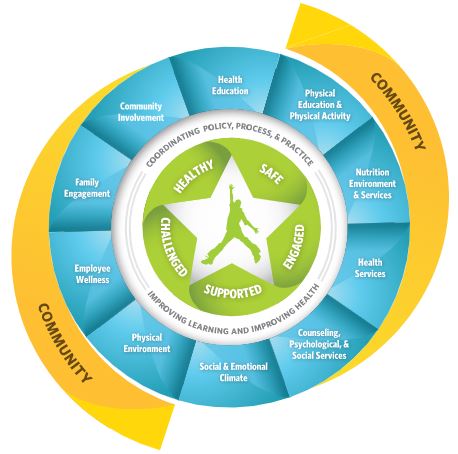Whole School, Whole Child, Whole Community
June 24, 2021
When school districts invest in the health of their students, they contribute to future, vibrant communities.
Healthy students are better learners. A student experiencing hunger, vision or hearing loss, or severe asthma will not perform well in school. As we work together across sectors to combat the COVID-19 pandemic, the link between health and schools has grown even closer as we grapple with how to keep students, staff, families, and communities healthy, safe, fed, and in good spirits.
Coordinated School Health invests in the Whole Child; establishing healthy behaviors during childhood is easier and more effective than trying to change unhealthy behaviors in adulthood. Schools play a critical role in promoting the health and safety of youth and helping them establish lifelong healthy behavior patterns, facilitating academic success.

The Centers for Disease Control and Prevention (CDC) and the Association for Supervision and Curriculum Development (ASCD) expanded on CSH and developed the Whole School, Whole Community, Whole Child (WSCC) model in collaboration with key leaders from the fields of health, public health, education, and school health.
The School Health Index (SHI): Self-Assessment & Planning Guide is an online self-assessment and planning tool (also available in a downloadable, printable version) that schools can use to improve their health and safety policies and programs.
The SHI was developed by CDC in partnership with school administrators and staff, school health experts, parents, and national nongovernmental health and education agencies.
Additional Resources from the CDC:
Mental Health:
- PowerPoint (April 2021): Promoting Mental and Behavioral Health Resources to Help Children and Teens Enroll in Coverage and Access Care Mental and Behavioral Health Resources (from Substance Abuse and Mental Health Services Administration)
Physical Health:
- Healthier School Communities: What's at Stake Now and What We Can Do About It (AASA and GENYOUth)
- Superintendent Leadership for School Breakfast
- Student Information Flyers about Sudden Cardiac Arrest (from Simon's Heart)
Community Health:
- Insure All Children
- Don't Wait, Vaccinate Toolkit (from UNITY: United for Adolescent Vaccination)
Advertisement
Advertisement
Advertisement
Advertisement

.png?sfvrsn=a318476e_7)

